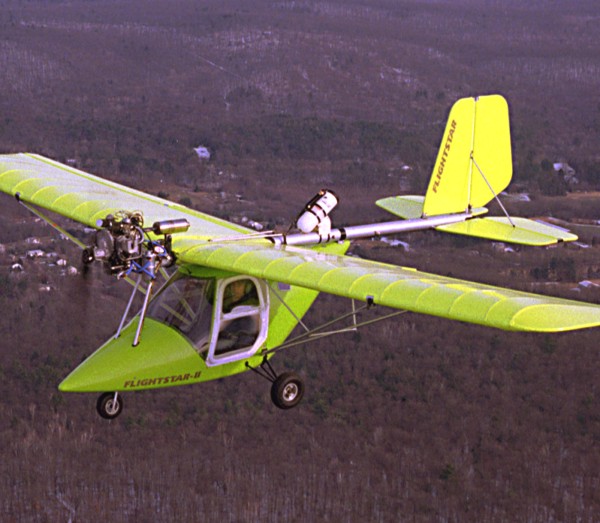
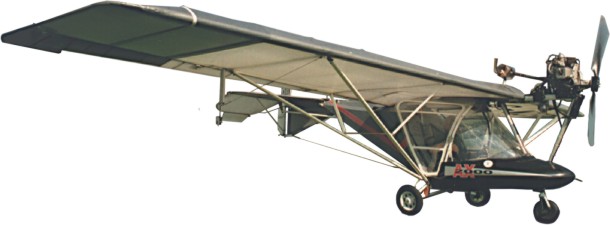
BRITISH TRAINER – Big UK trike maker Pegasus also sells this AX2000, a derivative of the Weedhopper. They equipped it with the HKS engine.
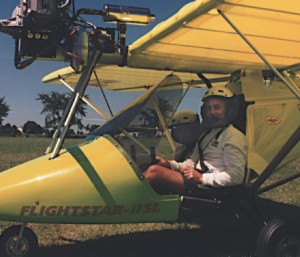
LESSON MACHINE – Flightstar partner Spark Lamontagne takes a youngster up for a lesson in the HKS-powered Flightstar II SL.
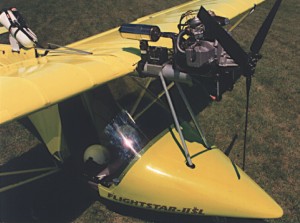
FOUR-STROKER – Flightstar installed the new HKS 700E on their Flightstar II SL model to give the Japanese engine its American debut in August ’97.
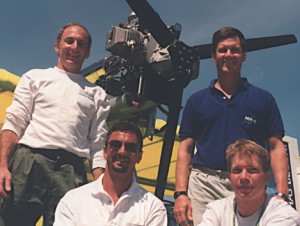
POWER TEAM – In its coming-out party, the HPower company had this hard-working team comprised of (left to right, rear) Spark Lamontagne and Tom Peghiny, and (front) Ken Godin and Jonathan Carter.

SALES PITCH – HPower boss Tom Peghiny fielded hundreds of questions from visitors to his booth. He says the usual “question” was actually a statement of appreciation for offering the new powerplant.

TOTAL PACKAGE – The HKS engine is more complex than an equivalent 2-stroke engine, but you get the well-regarded reliability of a 4-stroke.

FIRST UP – Even before Flightstar debuted the HKS engine in America, Pegasus showed the powerplant in England on their AX2000 a couple months earlier.

LIFT OFF! – The confidence-inspiring 4-stroke engine helps bring a smile to the faces of students or passengers who go aloft with it.

FULLY CERTIFIED – In England, Pegasus went to the trouble of obtaining the difficult BCAR S certification for the AX2000. The curved tube at the left of the cockpit is the throttle, changed to conform to UK certification rules.

BIG CHANGE – If you look hard, you can tell this AX2000 derives from the venerable Weedhopper design. However, this plane has gone through so many changes it isn’t any longer the Weedhopper.

TOP GUN – Bill Sherlock is a director of Pegasus and the proud operator of this HKS-powered AX2000 aircraft. The British company manufactures the 3-axis design.

NEW EMPENNAGE – Though it bears some resemblance to the Weedhopper’s simple tail, this one features extra strength and aerodynamic controls like the in-flight trim seen on the right elevator.

So, Why Not Stick With Rotax?
It isn’t often I can do “scouting party” duty on engines. Powerplants aren’t normally my focus. They
are a necessity for flight, but they aren’t my main attraction. A great many pilots I’ve met appear to be just the reverse: They are extremely interested in engines.
I enjoyed the chance to fly behind the first European and first American installations of the new 60-hp HKS 700E 4-stroke from Japan’s HKS Company Ltd. With that in mind, this pilot’s report is rather different. We’ll look at this new engine on two different aircraft.
As all Ultralight Flying! readers know, Rotax has enjoyed great success for more than a decade as an ultralight engine supplier. After dominating the 2-stroke market, Rotax introduced the 81-hp Rotax 912 4-stroke, which has become a popular powerplant choice for sport aviation aircraft.
Is a 4-Stroke Better?
All 4-stroke engine manufacturers trumpet their advantages over 2-strokes: lower fuel consumption, quieter operation, longer time between overhaul, and reliability.
Offsetting these pluses are: increased weight, complexity and cost. Nonetheless, 4-strokes are widely believed to offer greater reliability, and this alone causes some pilots to prefer them. Some experts protest, insisting that a well-maintained 2-stroke will run hour for hour with a similarly maintained 4-stroke. Note: this is not an equal comparison of engines. Much more information is available to help you decide which engine is right for you.
“Rotax 2-strokes have been unfairly blamed for poor or unengineered installations or poor maintenance,” says Tom Peghiny, president of HPower, the U.S. importer of the HKS 700E engine. He agrees with many users that the Rotax 503 is one of the best engines available for light aircraft, and that, properly serviced, it can last a very long time. He should know. His company flight school 503-equipped Flightstar has been through three overhauls – that’s a lot of hours!
Nonetheless, you can’t deny the appeal of the 4-stroke power-
plants, and with it the potential for a competitor to the 65-hp Rotax 582 2-stroker.
Japanese Engine
A couple decades back, Volkswagen sold a lot of cars in the U.S. auto market. Beetles were everywhere; they even became hip. Then came the Japanese. Today, older VW Bugs are increasingly scarce (a new “VW Bug” is being introduced this year). Japan even challenges Detroit.
Given that earlier scenario, Rotax might be concerned about the arrival of the 60-hp HKS 700E, a new horizontally opposed 2-cylinder 4-stroke engine designed expressly for sport aviation, from “Japan Inc.”
Helping to introduce the HKS brand is HPower Ltd., a new company formed by the principals at Flightstar Sportplanes. Though unknown to most Americans, the Japanese firm is already “a world leader in high-performance engines and components,” says HPower’s Peghiny.
For more technically-aware readers, other enticements come with this advanced powerplant. The 700E features a hydraulic valve train operated by a single cam with cylinder-encased pushrods. And thanks to a dry sump lubrication system, either a tractor or pusher installation can be performed. HPower says inverted installations are not approved.
By example, the Japanese penchant for quality is seen through a full factory break-in procedure, which saves the builder such a chore. In their Shizuoka, Japan plant, HKS puts 11¼2 hours on each 700E before it ships.
HKS is a technology development company known in all forms of motorsports and the automotive after-market business. The 20-year-old company has a large and impressive facility employing 400 workers. Bombardier-Rotax is far larger, but HKS is clearly able to mount a serious challenge to the Austrian giant.
Since Japanese engines have earned the respect of those in the know, the ensuing battle for market share could be interesting. More importantly, this provides ultralight enthusiasts with more choices. Choice is good.
Flightstar and the HKS
In-flight aboard a Flightstar II SL equipped with the 700E, you can operate at 4,500 rpm and raise the nose without throttle change. With most 2-stroke engines, you would quickly hear the prop load up and the engine labor. Behind the HKS, no such loading was perceptible right up to stall, thanks to a flatter torque curve.
At 21¼2 gallons per hour fuel use, pilots will also find something to like in the HKS: much lower operating costs – and no oil mixing!
Fully-equipped with oil tank, electric starter and custom stainless steel exhaust system, the HKS 700E weighs in at a relatively trim 116 pounds. Some automotive conversion engines are said to weigh significantly more.
“In addition, the engine’s small size (16 by 24 inches) will package well in many existing aircraft installations and cowlings,” Peghiny told me while we flew along in relative quiet compared to Flightstar’s more common 50-hp Rotax 503. To assure better fitting, HPower has been in close conversation with many ultralight manufacturers in the effort to refine the installation.
In many ways, the Flightstar is the same aircraft as it is with the Rotax 503. You can, however, easily sense the broader torque curve, even if you think you don’t normally observe such things.
In the Flightstar, I was able to maintain altitude down below 4,000 rpm. At this setting and given a lower overall noise output, the HKS appeared merely to be purring. Anyone would enjoy the low-noise, low-vibration combination, I think.
The system is more complex than a 503 installation, but
it is roughly on par with an electric start 65-hp Rotax 582. It appears less complicated than an 81-hp Rotax 912, and is certainly simpler than a 115-hp Rotax 914 Turbo installation.
From a pilot’s standpoint, the engine requires less work than a liquid-cooled Rotax 582 where, for example, you should assure sufficient water temperature before takeoff. In flight, interacting with the engine is similar to the 582.
Compared to a 503 installation, the HKS brings a power boost, so you may see a couple miles an hour more speed, but possibly not as much increase in climb, reports Mike Kern of HY-TEK Hurricane, who mounted a 700E on one of his Hurricanes. The extra weight – over a 503 with pull starter – uses up some of the added power the HKS engine offers.
Compared more favorably to the 582 it truly aims at, the 700E has a few less horses and a few extra pounds. Naturally, this means it is not an identical replacement. Yet that is precisely the point. HKS is supposedto be a different engine experience. It is, and I liked it. My sense of hearing liked it a lot.
Britain’s AX2000
Yes, I know it looks something like a Weedhopper. Matter of fact, those of you who thought so are exactly right. The AX2000 and its predecessor, the AX3, are derived from the original Weedhopper. In truth, more than one company supplies Weedhopper derivations. The Europeans, especially the French, seem to have embraced the Weedhopper even as it lost its dominant position in the U.S.
A French company called Ultralair sold the design rights, and today the aircraft is available under the umbrella of Pegasus Aviation. Pegasus is one of the two largest microlight manufacturers in the United Kingdom. Until the AX3 and now AX2000, they produced only trikes. The 3-axis model is fully certified under the British microlight rule, which I’ve examined and found to be a tough regulation.
The AX3 meets current British regs which limit gross weight to 390 kilograms (860 pounds), but those rules may soon switch to the international microlight standard of 450 kilograms (992 pounds). Although some trike makers told me they may choose not to use the new weight – weight-shift control becomes more tiring when weight goes up that much – the AX2000 is developed precisely to the greater weight limit. In fact, until the new rule becomes effective at home, the AX2000 is sold for export only. All this makes the AX2000 a ripe candidate for the HKS engine.
I’ve also flown the single-place Weedhopper and can say this: The two aircraft may look vaguely alike and share a common design heritage, but that’s where it ends. These are very different machines. Despite the many modifications, the John Chotia-designed Weedhopper wing remains speedier than you might expect. It worked very well with the steady pull of the HKS.
Both the Flightstar II SL and the AX2000 cruised quite comfortably at 60 to 70 mph. Obviously, different designs will perform differently with the same HKS engine doing the work.
In a very ultralight turn of fact, I perceived that both planes performed well at low power settings. The HKS is marvelously quiet and smooth, and both the Flightstar II SL and AX2000 flew nicely at ultralight speeds, down into the 50s. I enjoyed the sensation of ultralight-style flight with the added comfort of a 4-stroke engine. I think a lot of pilots may feel similarly.
Good Timing
Certainly the ultralight community of today is ripe for the introduction of the HKS 700E. Many school operators flying Part 103 training exemption 2-seaters would enjoy the long overhaul cycle and reduced operating cost. Ultralight designs which use the Rotax 503, 582 or even 618 engines may prefer the 4-stroke rhythm enough to select HKS.
I can foresee HKS grabbing a fair piece of the market. Customers are embracing the concept and HPower personnel – the same as the Flightstar staff – have earned a reputation for superior service. Put it together, and you may see an HKS near you soon.
On whole, I enjoyed flying both the Flightstar II SL and the AX2000 with the HKS engine. Flightstar had more time to refine the mount by the time I flew it, but both aircraft were confidence-inspiring as the 700E purred along. I enjoy flight with 2-stroke engines; I believe they do a fine job. But even I was sorely tempted by the smooth response from Japan and HPower.
| Gross weight | 103 pounds |
| Exhaust system weight | 7 pounds |
| Oil tank/cooler weight | 6 pounds |
| Total Installed weight | 116 pounds |
| Displacement | 680cc (42 cubic inches) |
| Bore | 85 mm |
| Stroke | 60 mm |
| Gearbox ratio | 2.58-to-1 or 3.52-to-1 |
| Compression ratio | 11.3-to-1 |
| Fuel | Autogas, unleaded premium |
| Ignition | Dual CDI |
| Time Between Overhaul | 500 hours (Initial inspection) |
| Power | 60 hp at 6,200 rpm |
| Torque | 58 foot pounds |
| Fuel Consumption | 2.6 gph at 75% power |
Design
Cosmetic appearance, structural integrity, achievement of design goals, effectiveness of aerodynamics, ergonomics.
Pros – All-new 4-stroke, twin-cylinder horizontally opposed powerplant from Japan. Complete package with technical support during installation. Technically advanced engine product which includes a prop-speed reduction unit. Fitting is in progress for several designs.
Cons – Only available in 60-horse configuration at this time, though a “half-HKS” has been pondered, as has a 4-cylinder model with 120 horsepower. Four-stroke engines have more parts to maintain and this pushes up the purchase price.
Systems
Subsystems available to pilot such as: Flaps; Fuel sources; Electric start; In-air restart; Brakes; Engine controls; Navigations; Radio; (items covered may be optional).
Pros – The 700E comes standard with prop-speed reduction unit, electric start and external oil tank and cooler. It features dual carburetors and ignition is dual CDI. Exhaust is stainless steel. Air-cooling suffices for cylinders, while heads are oil-cooled.
Cons – More systems means more pilot work, although the Rotax 582 it competes with requires attention to a liquid-cooling system and radiators.
Cockpit/Cabin
Instrumentation; Ergonomics of controls; Creature comforts; (items covered may be optional).
Pros – A large diameter, integral flywheel dampens torsional vibration. Though more complex, the 700E installed on either a Flightstar or AX2000 in tractor configuration did not obscure vision more than a 503 would have.
Cons – The engine itself makes a compact installation, but its peripheral items such as muffler and oil cooler make the engine appear busier than a Rotax 582 or certainly a 503.
Ground Handling
Taxi visibility; Steering; Turn radius; Shock absorption; Stance/Stability; Braking.
Pros – Start it up, taxi out – with minimal waiting required, you can be flying quickly with the air-cooled HKS engine. The 700E lacks the temperature sensitivity of some engines. Nickel-coated cylinders are said to help this.
Cons – The 700E lacks the quick spin up of a 2-stroke engine, so you must anticipate power needs sooner (though the difference is very minor on light aircraft).
Takeoff/Landing
Qualities; Efficiency; Ease; Comparative values.
Pros – While the 700E may yield a slightly longer spool-up than a 2-stroke engine, the torque will make itself felt. Climb didn’t seem to give the HKS any extra workout in either the Flightstar II SL or AX2000.
Cons – Quick additions of throttle may not deliver power as quickly as some 2-stroke engines; you must plan ahead a little bit longer (the same as when flying heavier aircraft in general).
Control
Quality and quantity for: Coordination; Authority; Pressures; Response; and Coupling.
Pros – No need to worry about oil mixtures or water temperatures. No additional pilot controls needed to operate the 700E.
Cons – No negatives.
Performance
Climb; Glide; Sink; Cruise/stall/max speeds; Endurance; Range; Maneuverability.
Pros – HKS 700E compares well to the Rotax 582 (which has 5 more horsepower) and is substantially more powerful than either a single- or dual-carb Rotax 503 it might also replace. Some top speed increase likely compared to the 503.
Cons – Adds 6 pounds compared to a 582-equipped airplane, or nearly 30 to a 503 aircraft, so climb increase may not be the same as expected when comparing horsepower figures.
Stability
Stall recovery and characteristics; Dampening; Spiral stability; Adverse yaw qualities.
Pros – Four-stroke engines may reward their buyers the most when flying cross-country across unfamiliar territory (you should always have a safe place to land within gliding distance). Greater fuel economy can also aid safe flying.
Cons – Installations of different engines require operators to perform new weight and balance calculations. Overlooking this could bring grave consequences; always redo weight and balance after any equipment addition.
Overall
Addresses the questions: “Will a buyer get what he/she expects to buy, and did the designer/builder achieve the chosen goal?”
Pros – Marketing in North America by HPower Ltd., whose staff (same as Flightstar Sportplanes) enjoys an excellent service reputation. Buying is easy and service is great. HPower is working with many airframe builders to fit the HKS engine; several are ready and flying now.
Cons – Some aircraft aren’t served by the 700E (yet); Part 103 ultralights don’t need this power, weight, cost or complexity. Not all aircraft that are appropriate have been fitted yet. New installations take time.


I have a flightstar model> loadstar 1 seater with a HKS 700E
need pictures on install the engine and things that go with it!
My buddy just passed away, and I got this plane.
thanks
jack
How does the HKS 700E perform in a Skyranger?
Hi George: I don’t have direct experience with that combination but I feel sure it would perform OK as I flew it with a less powerful Rotax 503 way back when. However, neither aircraft nor engine is currently available in the USA, so consider that, presuming you are looking at a used aircraft.